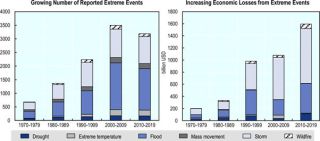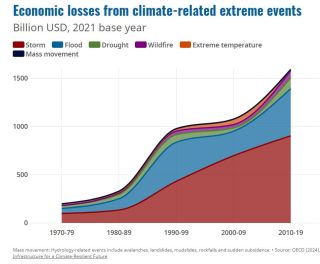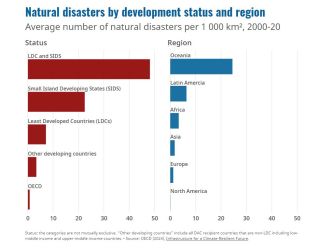Infrastructure planning and climate change

A new report from the OECD ‘Infrastructure for a Climate-Resilient Future’ looks at the impact of climate events on our infrastructure. This report provides an overview of the impacts of climate change on infrastructure, and key policy areas to be considered to render infrastructure more resilient. It discusses advances and persisting gaps in planning and developing infrastructure across its lifecycle to build in climate resilience and how this can be fostered by place-based approach.
Context
Infrastructure is key to a well-functioning society and economy, enabling the circulation of people, goods, services and information. However, climate-related disasters can lead to widespread infrastructure failure and damage, which disproportionately impacts developing countries. Governments, at all levels, should systematically factor climate resilience into infrastructure planning and decision-making, including by prioritising sustainable projects, to help reduce societal and economic vulnerability and avoid long-term costs. Global average temperatures set a record in 2023, rising to around 1.4 °C above the preindustrial average. Behind this rise lies the growing frequency and severity of extreme events such as heatwaves and floods, as well as gradual onset changes such as droughts and inundation by rising seas. Some future climate impacts are now inevitable, but the consequences of those impacts are not. Enhanced efforts to prepare for the impacts of climate change are a vital complement to mitigation efforts.
The number of reported extreme events and economic losses have grown

Note: Monetary value calculated in USD, adjusted for inflation with 2021 as the base year.
Mass movements include avalanches, landslides, mudslides, rockfalls and sudden subsidence.
Source: Based on EM-DAT (2023[15]), International Disasters, https://www.emdat.be/publications/.
Infrastructure and climate resilience are closely linked. First, climate change poses direct and indirect risks to infrastructure assets and service provision, such as when roads melt, reservoirs run dry and tunnels flood. Impacts in one area can lead to downstream economic and social impacts as disruptions ripple through infrastructure networks. Second, infrastructure can exacerbate climate-related risks. Sparks from electrical transmission lines, for example, can ignite wildfires, and heavy rains can set off catastrophic dam failures. Third, climate change will create new demands for infrastructure, such as reinforcement of flood defences.
Given these challenges, there is an urgent need to make climate resilience standard practice for infrastructure. Choices made today about infrastructure provision will have impacts for decades to come; it is vital to build resilience rather than lock in vulnerability. In practice, this means that infrastructure should be planned, designed, built and operated in ways that anticipate, prepare for and adapt to a changing climate. This complements efforts to ensure that infrastructure contributes to the transition to net zero. Climate resilience should be considered from the outset for new assets. Ageing infrastructure may need to be replaced or adapted to meet today’s needs. Existing assets may need to be retrofitted or operated differently to account for climate change impacts over the course of the asset’s life.
Economic impact
There are significant economic losses due to climate-related damage to infrastructure. With record global temperatures around 1.4 degrees Celsius above pre-industrial averages in 2023, the world is experiencing more severe heatwaves and floods, more frequent droughts, longer wildfire seasons and rising sea levels. Between the 1970s and the 2010s, the number of recorded climate-related extreme events increased significantly, while recorded economic losses from such disasters increased sevenfold from USD 198 billion to USD 1.6 trillion. Infrastructure assets make up an important share of this economic damage.

There is a compelling economic argument for investing in climate-resilient infrastructure. Well-targeted and timely investments can help protect lives and livelihoods, improve service reliability, reduce maintenance, extend asset lifetimes and generate co-benefits. Every dollar invested in climate-resilient infrastructure yields about four dollars of benefits.
Impact on Developing Countries
Developing countries are particularly vulnerable to extreme weather events, as they are to all natural disasters, especially the Least Developed Countries (LDCs) and Small Island Developing States (SIDS). High financing costs and other challenges also hinder their ability to build quality infrastructure and achieve their development goals. The escalating frequency and severity of climate-related events, such as extreme storms, floods, droughts and heatwaves, are placing unprecedented strain on infrastructure systems, including in transportation, energy, water and telecommunications. These infrastructures and their effective functioning are key for sustainable development. Making them climate resilient is therefore a shared priority for countries at all levels of economic development. The imperative for climate-resilient infrastructure in developing countries is underscored by the disproportionate impact of climate change on these nations. These countries contribute the least to global greenhouse gas (GHG) emissions in per capita terms. Yet they often bear the brunt of climate-related disasters due to their geographical location, limited adaptive capacity and socio-economic vulnerabilities. Developing countries face unique challenges in adapting to the growing challenges posed by the climate crisis due to limited resources and inadequate infrastructure. In addition, the lack of resilient infrastructure hampers efforts to achieve the Sustainable Development Goals, perpetuating cycles of poverty and inequality.

Addressing these challenges necessitates a multifaceted approach that integrates climate resilience into infrastructure planning, design and implementation processes. Governments in developing countries must prioritise climate-resilient infrastructure in national and local development policies and strategies, integrating climate risk assessments, adaptation measures and community engagement into decision-making processes. Additionally, they need substantial support from the international community to enhance capacities to plan, finance, build and operate climate-resilient infrastructure. Investments, international partnerships, including financial assistance, technology transfer and capacity building, are indispensable.
Policy Recommendations
Systematically integrate climate change into infrastructure planning to ensure the resilience of infrastructure systems and manage interdependencies
- Climate resilience should be mainstreamed into planning to ensure that infrastructure can withstand future climate-related risks. At the same time, stakeholders should be involved in decisions that will affect the placement and impact of infrastructure as well as land use.
Mainstream climate resilience into infrastructure financing and investments to make climate-resilience the norm for all investments and unlock capital for adaptation
- Finance flows for climate-resilient infrastructure are insufficient to address the growing impacts of climate change. Market failures, policy misalignments and lack of risk awareness are preventing public and private investment decisions to account for the benefits of increased climate resilience.
Unlock the potential of Nature-based Solutions (NbS) for providing cost-effective and flexible infrastructure services, as well as social and environmental co-benefits
- NbS can substitute, complement or safeguard conventional climate risk reduction solutions. However, unleashing the potential of NbS will require integration across the policy, regulatory, finance and institutional frameworks that enable infrastructure development, and incorporation in technical training programmes for designers and operators of infrastructure.
Address the unique challenges and opportunities faced by developing countries
- For developing countries, the imperative of climate-resilient infrastructure goes hand in hand with the need to close the infrastructure gap. Addressing social equity and inclusion is paramount when planning climate-resilient infrastructure in developing countries, where inadequate infrastructure can disproportionately affect vulnerable and marginalised communities.
Take an integrated approach to create more climate-resilient regions and cities
- Climate-resilient infrastructure can help communities adapt to climate change as part of long-term regional and urban development. Regional and local governments will play an essential role in building climate-resilient infrastructure. Subnational governments were responsible for 69% of climate-significant public investment in OECD countries. They have the mandate to plan, deliver, fund and maintain much of the climate-resilient infrastructure required. They also have responsibilities for setting local framework conditions for climate resilience investment.
OECD ‘Infrastructure for a Climate-Resilient Future’ is available here.